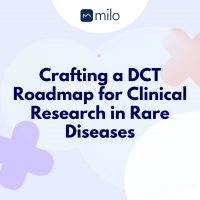Less than 10% of rare diseases have an effective treatment, while over a billion patients and caregivers are affected by rare diseases. Decentralized clinical trials tools like MILO can make rare disease research feasible for patients and trial teams, helping the enlargement of available therapies.
This article covers:
- Bringing enough patients to create significant results
- Unique challenges to rare disease clinical trials
- How DCT tools can face these challenges
- Advantages of DCT technology to improve patient experience and workflow efficiency in your trial
Discrimination between rare disease and traditional clinical trials
The widely dispersed populations complicate finding pivotal sites for rare disease trials. Rare diseases frequently affect small populations spread over the globe. For example, some patients diagnosed with a rare genetic disorder may live in Europe, while others live in southern China.
Demographics of the patient
Numerous rare diseases happen in pediatric populations, therefore researchers must plan for the complexities of including legally authorized representatives, such as parents, in the trial workflow. This way, many traditional clinical trials recruit adult patients to simplify elements like informed consent, and rare disease trials must adapt the consent process for the pediatric population.
Recruitment for rare disease clinical trials can be slower than recruitment for traditional trials because of small patient populations. Researchers may need to communicate with patients individually or by partnering with advocacy groups instead of relying on broad efforts like media for example.
Likewise, study groups may want to extend the time they spend collecting data to learn as much as possible about the rare disease. Both of these factors can increase trial timelines for rare disease surveys.
Choosing appropriate clinical endpoints
Traditional trials normally have settled clinical endpoints to choose from. These types of widely accepted tools are not necessarily available for rare diseases. Researchers must put extra effort into finding reliable measurements of treatment efficacy because rare diseases often lack existing literature on disease progression or previous studies.
Enhance Your Personalized Digital Learning Experience Independently
Welcome to MILO DCT, your platform for creating personalized clinical studies with unparalleled autonomy. Quickly design studies while leveraging decentralized solutions for improved data collection, management, and patient engagement.

How MILO DCT technology face rare disease research challenges
Decentralized clinical trial tools like MILO eConcent, electronic patient-reported outcomes MILO ePRO, electronic clinician-reported outcome assessments (eCOA), and integrations like real-world data (RWD) can help face the challenges rare disease trials pose for patients, their caregivers, and researchers.
Let’s illustrate how MILO technology could improve trial workflow and patient experience using a hypothetical trial of a treatment for Schnitzler’s syndrome, a rare autoinflammatory condition.
Simplifying recruitment, enrollment, and follow-up with MILO eConsent
Less than 1,000 people in the US are diagnosed with Schnitzler’s syndrome. Researchers can use simple and engaging technology to meet their enrollment goals despite the small number of potential participants. Those can use the MILO eConsent to:
- Screen, enroll, and consent patients from the comfort of their homes
- Give patients time and space to review consent materials at their leisure
- Include creative multimedia elements, dinamyzing processes to educate patients better
- Safely store patient data
- Send automated follow-up reminders to patients to sign forms
- Guarantee patient compliance with the consent process to meet regulatory approval
Like many rare diseases, much about Schnitzler’s syndrome is unknown. Researchers may need to adjust the protocol mid-study to accommodate new developments. If changes require reconsent, researchers can use the MILO eConsent tool to automatically send patients the most recent version of the informed consent form (ICF) to sign.
Researchers would likely want to follow patients after trial completion to gather more data and improve the collective knowledge of the disease. Reconsenting for follow-up through registries or new studies with the same eConsent tool used for enrollment simplifies the patient experience.
Upgrading the participation experience with MILO ePRO and EDC
Traveling to a research site is a huge burden for patients struggling with symptoms, especially those living far from sites since patients with Schnitzler’s syndrome often experience debilitating symptoms, such as joint and bone pain, hives, and fatigue. Researchers can limit travel using remote data collection tools like MILO ePRO and wearables to track vitals. Data from wearables flow directly into the trial’s electronic data capture (EDC) system via an application programming interface (API).
Researchers can also use the data stored securely in the EDC system to make real-time decisions to adjust the trial design. This flexibility is especially significant for rare disease clinical trials, where the lack of knowledge about the natural history of the illness can limit initial designs.
Hereafter is a summary of where to incorporate decentralized clinical trial (DCT) tools in your rare disease research.
Milo eConsent
- Recruitment
- Enrollment
- Informed consent
Milo eCOA & ePRO
- Gather clinical data remotely
- Schedule surveys and send reminders
Milo EDC
- Collect Data
- Manage/store data
- Integrate data from other DCT tools
- Access data for real-time decision-making
RWD – Real World Data
- Collect data from wearable and other digital health technology
Discover How Milo Can Benefit You

Winning challenges in adopting MILO DCT tools
Understanding where to use DCT technology in your rare disease research is an important first step to adoption. A large number of rare disease studies benefit from a hybrid approach—using a mix of traditional and remote tools. Including digital tools in the initial study design improves adoption, although many decentralized research tools can scale as the study progresses.
Involving sites, regulatory agencies, sponsors, patient representatives, and caregiver input in the planning process can also increase the adoption of DCT tools. Site and patient feedback help ensure the tools make workflow simpler, not haviest. Representatives from ethics committees can also help streamline the approval process for MILO eConsent and other digital tools.
Subscribe to Our Newsletter!
Unlock exclusive insights, expert tips, and the latest updates in telemedicine and urology healthcare. Join our community today and stay informed about groundbreaking advancements that can revolutionize your practice.






